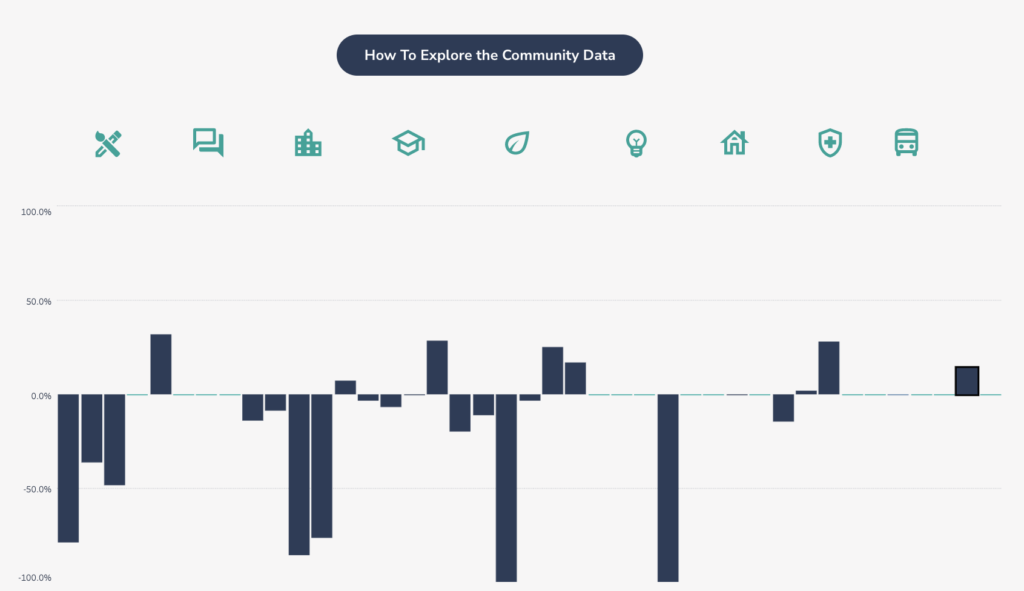The 2030 goals that make up San Antonio’s shared community vision show us what is possible in overcoming the pandemic and remaining visionary. Annual data offers critical information to help shape policies and investments and improve the well-being of San Antonians. At SA2020.org you can explore the updated data for 56 Community Indicators, learn about how they relate to each other, and identify your power to affect change.
We use 5 icons to show how these indicators are trending—either closer to or further away—from the goal set for 2030.

This is the first look at how San Antonio is doing in relation to the goals set for 2030. A couple things to keep in mind:
- For 13 of the 56 indicators only baseline data is available, largely due to the impact of the COVID-19 crisis. Baseline data refers to the first year of data that informs the decade-long goal. At least one more year of data beyond the baseline must be known to report on progress.
- Another 15 indicators are “In Development.” SA2020 will continue to work with Partner organizations and other stakeholders to identify the best measure for priorities named by San Antonians during the visioning process (e.g. the accessibility of public transit and sidewalks)
As you explore the community indicators, know that they’re all interrelated, meaning that progress toward one can move the needle on others, too.
Ninety percent of Bexar County students, for example, graduate from high school. While this is a significant achievement from the first decade of progress, a recent study by the University of Texas at San Antonio’s Urban Education Institute shows that peoples’ annual wages grow with advanced degrees.
Today, 25% of San Antonians, ages 25-34, hold a certificate or degree beyond high school. The 2030 goal calls for 60% with an emphasis on supporting graduating high school seniors with getting into college and graduating.
The shared vision also calls for more people to be able to afford their homes. One in three San Antonians can’t afford their homes, and there is an overburden of housing costs on those who rent versus those who own. According to The National Low Income Housing Coalition, a person in the San Antonio/New Braunfels area must make $21.42/hour to afford a 2-bedroom rental home. The minimum wage is just $7.25/hour.
In 2021, City Council passed the Strategic Housing Implementation Plan (SHIP), a ten-year plan to increase City investment in housing; increase affordable housing production, rehabilitation, and preservation; protect and promote neighborhoods; and ensure accountability to the public.
One way you can help ensure accountability to the shared vision is by voting. The 2021 municipal election was the largest turnout in Bexar County history for a municipal election, with 17% of registered voters casting their ballot. Between 2011 and 2019, San Antonians increased municipal voter turnout by 78.8%. If this trend continues for the next decade, San Antonio will surpass the shared goal of increasing voter turnout in municipal elections to 30% by 2030.

You don’t have to wait for the next municipal election to cast your ballot. Early voting begins February 14 for the Primary Election on March 1. Research shows that voting three consecutive times helps make it a habit.
We invite you to explore the community data at SA2020.org and be curious: “Why is this Indicator moving?” “Why is this Indicator not moving?” “How can I use my influence and experience to make an impact on the shared vision?” Then consider the power you have to affect change and commit to a call to action. Here are a few to get you started:
- Spread the word about San Antonio’s Community Vision within your circles.
- Support SA2020’s ability to tell a more complete story of San Antonio’s progress by completing our Biennial Survey (available in English and Spanish) and sharing it with people in your network.
- Connect with SA2020 Nonprofit Partners and volunteer your time or donate dollars.
- Support SA2020 in driving progress toward the shared Community Vision by donating monthly.
- Get registered and vote, if you’re eligible. Visit ilovesanantonio.org for information on the upcoming primary election.
For a complete list of calls to action, visit SA2020.org/data.

